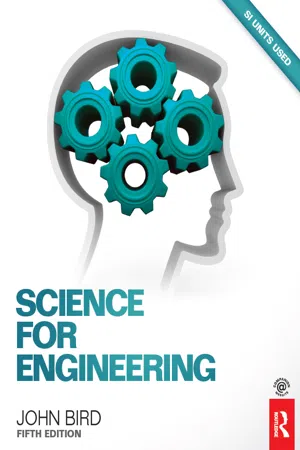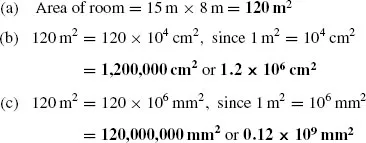
- 512 pages
- English
- ePUB (mobile friendly)
- Available on iOS & Android
Science for Engineering
About this book
A practical introduction to the engineering science required for engineering study and practice.
Science for Engineering is an introductory textbook that assumes no prior background in engineering. This new edition covers the fundamental scientific knowledge that all trainee engineers must acquire in order to pass their exams, and has been brought fully in line with the compulsory science and mathematics units in the new engineering course specifications.
John Bird focuses upon engineering examples, enabling students to develop a sound understanding of engineering systems in terms of the basic laws and principles. This book includes over 580 worked examples, 1300 further problems, 425 multiple choice questions (with answers), and contains sections covering the mathematics that students will require within their engineering studies, mechanical applications, electrical applications and engineering systems.
-
- Colour layout helps navigation and highlights key learning points, formulae and exercises
-
- Understanding can be tested with the 580 worked examples, 1300 further problems and 425 multiple choice questions contained within the book
-
- Focuses on real-world situations and examples in order to maximise relevance to the student reader
-
This book is supported by a companion website of materials that can be found at www.routledge/cw/bird, this resource including fully worked solutions of all the further problems for students to access for the first time, and the full solutions and marking schemes for the revision tests found within the book for lecturers/instructors use. In addition, all 433 illustrations will be available for downloading by staff.
.
Frequently asked questions
- Essential is ideal for learners and professionals who enjoy exploring a wide range of subjects. Access the Essential Library with 800,000+ trusted titles and best-sellers across business, personal growth, and the humanities. Includes unlimited reading time and Standard Read Aloud voice.
- Complete: Perfect for advanced learners and researchers needing full, unrestricted access. Unlock 1.4M+ books across hundreds of subjects, including academic and specialized titles. The Complete Plan also includes advanced features like Premium Read Aloud and Research Assistant.
Please note we cannot support devices running on iOS 13 and Android 7 or earlier. Learn more about using the app.
Information
Quantity | Unit | Symbol | |
Length | metre | m | (1m = 100cm = 1000mm) |
Mass | kilogram | kg | (1kg = 1000g) |
Time | second | s | |
Electric current | ampere | A | |
Thermodynamic temperature | kelvin | K | (K=°C+273) |
Luminous intensity | candela | cd | |
Amount of substance | mole | mol | |








Table of contents
- Cover
- Half Title
- Title Page
- Copyright Page
- Dedication
- Table of Contents
- Preface
- SECTION I APPLIED MATHEMATICS
- SECTION II MECHANICAL APPLICATIONS
- SECTION III ELECTRICAL APPLICATIONS
- SECTION IV ENGINEERING SYSTEMS
- List of formulae for science for engineering
- Answers to practice exercises
- Glossary of terms
- Index